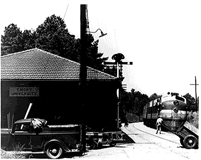E N I G M A
Next stop, Emory
On a cloudy weekday afternoon, Cappuccino Joe's coffee house at The Depot is swarming with students. Some eat lunch and watch CNN on the giant television, while others sip espresso, chat with friends, or relax and listen to the Muddy Waters album playing on the house stereo. A hip oasis from the rigors of academic life, for many students The Depot is the place to go on campus. What many of them don't know is that it used to be a great place to leave.
The depot was constructed in 1916 as a station for the Seaboard Air Line Railway. Until 1947, the official name of the station was "Emory, Georgia." That year it was changed to "Emory University" to better reflect its ties to the school. At one time, travelers could board the Silver Comet at Emory's small-town station and get off in the bustling megalopolis of New York City without ever having to switch trains.
The depot has an interesting, quirky history, and significant changes may even lie in its near future. During the 1940s, the station was home to Tom the Cat, the pet of station master Cheney C. Sigman Sr. Tom was something of a local celebrity because of his talent for turning door knobs with his paws. According to an article in the February 1949 issue of the Emory Alumnus, Tom "usually stays in the baggage room, but when he tires of those four walls he marches down a short flight of steps to the door, stands up on his hind legs, grabs the knob in his front paws and twists until the door pops open." At that time, the station master also allowed five-year-old locomotive fan and Emory neighbor David Grant to work as the depot's flagman, flashing a signal lamp to the Comet as it rolled into the station.
The depot has also played a role in American literature. In 1955, Southern Gothic writer Flannery O'Connor used the station as a location in her short story "The Artificial Nigger." The tale concerns a bigot who takes his grandson by train to Atlanta to show him the evil that lurks in the big city.
The conductor stuck his head in the car and snarled, "Firstopppppmry," and Nelson lunged out of his sitting position, trembling. Mr. Head pushed him down by the shoulder. "Keep your seat," he said in dignified tones. "The first stop is on the edge of town. The second stop is at the main railroad station."
Passenger service from the depot was discontinued in the fall of 1969, and the following year parcel service was stopped. For a short time, the long, narrow red brick building was used as a student art gallery, and then in 1972 it was converted into the Emory Employees Federal Credit Union. At one time, rumors circulated that the station would be turned into an English pub, but in 1982 the building became The Depot restaurant.
Freight trains still roar by on the two east-west sets of track just outside the windows of The Depot, but passenger service may one day return. A study partly financed by the University is examining the feasibility of linking Emory via train to the MARTA line at the Lindbergh Station. Parking woes and traffic congestion have long been problems at the University, and this proposed rail line could drastically reduce both.
"I see the light rail possibility as being the single most effective method of addressing our parking and traffic challenges at Emory," says Cheryle Crumley, director of transportation with the University's Community Services. "We're eager to see where this takes us."--J.D.T.
Return to Autumn 1997 contents page
